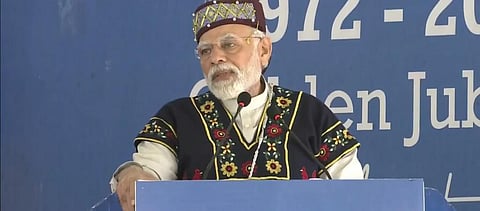Amrit Kaal vs New India: Why do we buy metaphysical political agenda in deep economic distress
The year 2023 is the penultimate one for the incumbent National Democratic Alliance (NDA)’s second tenure. In May 2024, the NDA led by Prime Minister Narendra Modi will face general elections.
Expectedly, one would tend to evaluate what promises were made and what were delivered, particularly for a government that is entering its tenth year in power.
In February, the government will present its last full budget. One would again look for this opportunity to check out whether the government would come out with a white paper on its own performance.
To refresh memories, 2022 was a year for the government to keep many grand and even transformative promises from its first tenure (2014-2019).
The grandest among them is the promise of achieving a ‘New India’ in 2022. This was to mark the milestone of India’s 75th year of independence. ‘New India’ was Modi’s personal promise to the nation.
To achieve this, the NITI Aayog announced the ‘Strategy for New India@75’ in 2018. After abandoning the Five Year Plan mode, the strategy for India@75 remains the only codified vision for the country, which had a delivery date last year.
So, did the government deliver on this grand promise in 2022? From becoming a $4 trillion economy to generating employment for women, doubling farmers’ income and eradicating poverty, there are some 41 targets under this strategy, of which at least 17 had a deadline in 2022.
During the 2022-2023 budget speech, one expected the finance minister to give a status on this promise. Rather, she didn’t even mention ‘New India’ and its development goals. She didn’t mention doubling farmers' income.
Instead, she said, “This Budget seeks to lay the foundation and give a blueprint to steer the economy over the Amrit Kaal of the next 25 years — from India at 75 to India at 100.”
But going by all indications, India has not met any of the targets fixed for 2022 under India@75, or ‘New India’. Modi has not mentioned the term ‘New India’ in the recent past as ‘Amrit Kaal’ has become his vision for development, without measurable indicators but with a distant deadline a quarter century away.
What would one expect in the budget for 2023-2024 to be presented next month? Being the last one before the general elections, it usually should be an indicator of what the government has done or intends to do, with those usual electoral benefits in mind.
But the context to this year’s budget is unprecedented. For the last three years the country has been in the grip of the COVID-19 pandemic. Before 2020, the country had been constantly facing economic slowdown for nearly three years with unemployment rising.
The pandemic has furthered this. We are yet to be at the pre-pandemic level of economic growth. Unemployment continues to be around 8 per cent as per the Centre for Monitoring Indian Economy’s November, 2022 data.
It is so frustrating for millions in the labour force that they have stopped looking for work. Agriculture is overcrowded as the last resort of sustenance even though it is no more paying for a decent survival.
Add to it, the rising inflation that ultimately demonetises one’s earning, consistently and for both poor and rich. Similarly, a widespread recession is setting in that will anyway impact the Indian economy in near future.
To sum up, a declining economy was hit by a pandemic that further damaged the hopes of the world’s largest work force which ultimately define the Indian economy. In this context the government has to bring in the budget for the next fiscal year and also to fight re-election a year after.
But, the government has consistently covered the economic crisis with a narrative that India’s economic growth is one of the “best” in the world, even if it is relative to one of the worst one in preceding year.
This also means that the next elections would be more about metaphysical agenda than on real development agenda or on the government’s grand promises. This metaphysical agenda could be sensed when the ‘Amrit Kaal’ was declared in the last budget.
As the narrative becomes more mythical, we as a country are entering a fairy tale world where each of us is told to assume an illusory sense of global power and a divine-like feeling. And to express this in a modern electoral system, like the bell in a temple, we have to press the button in the voting machine in approval.


